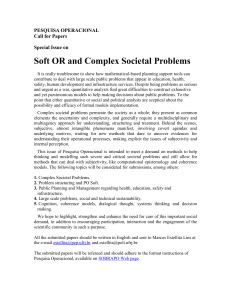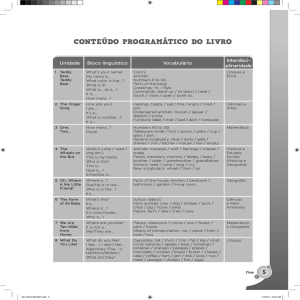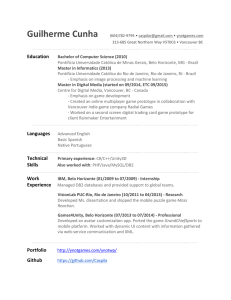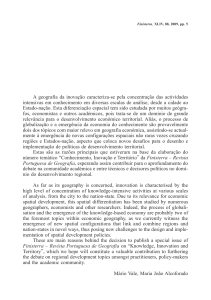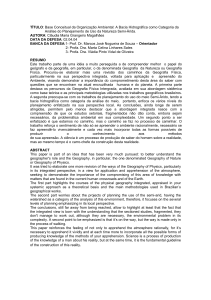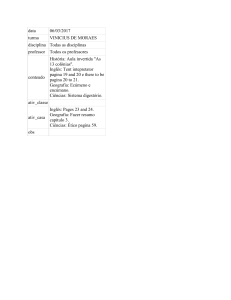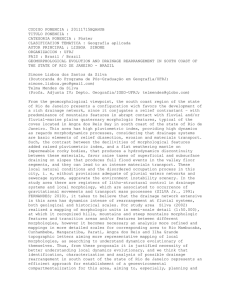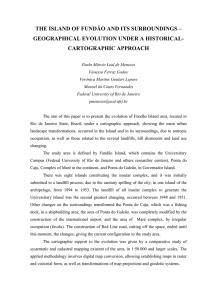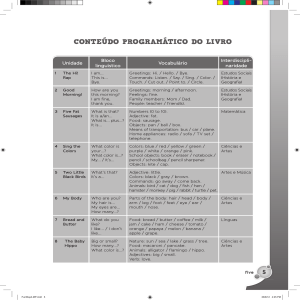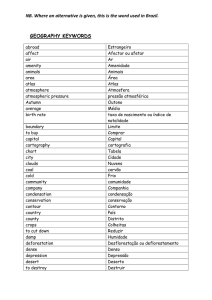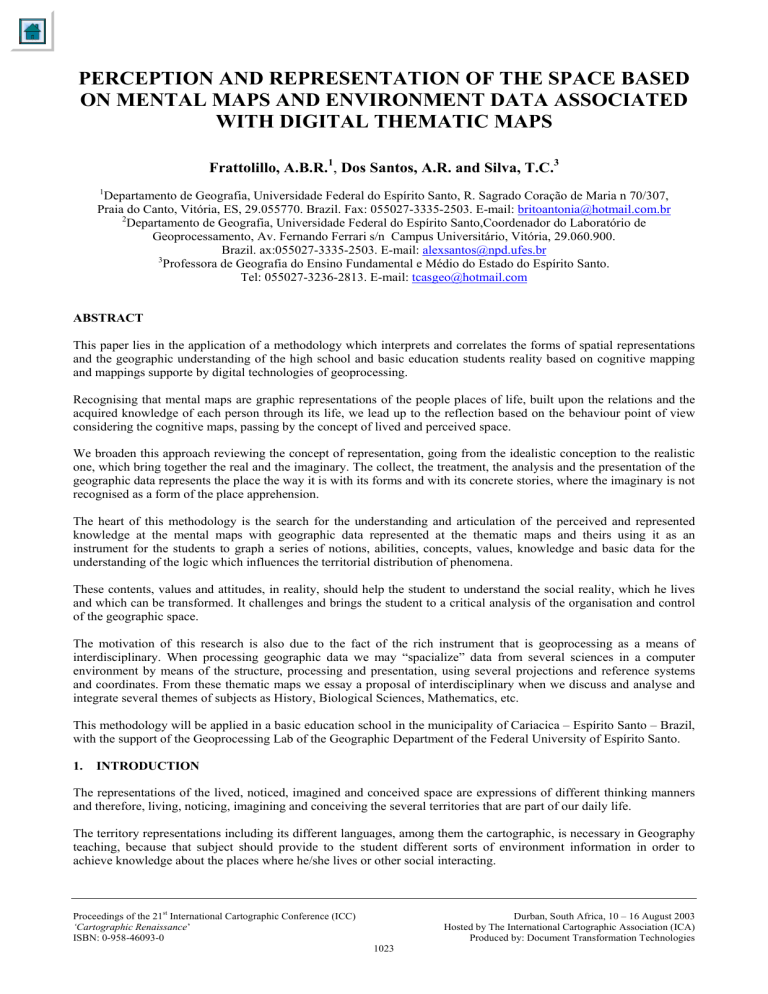
PERCEPTION AND REPRESENTATION OF THE SPACE BASED
ON MENTAL MAPS AND ENVIRONMENT DATA ASSOCIATED
WITH DIGITAL THEMATIC MAPS
Frattolillo, A.B.R.1, Dos Santos, A.R. and Silva, T.C.3
1
Departamento de Geografia, Universidade Federal do Espírito Santo, R. Sagrado Coração de Maria n 70/307,
Praia do Canto, Vitória, ES, 29.055770. Brazil. Fax: 055027-3335-2503. E-mail: [email protected]
2
Departamento de Geografia, Universidade Federal do Espírito Santo,Coordenador do Laboratório de
Geoprocessamento, Av. Fernando Ferrari s/n Campus Universitário, Vitória, 29.060.900.
Brazil. ax:055027-3335-2503. E-mail: [email protected]
3
Professora de Geografia do Ensino Fundamental e Médio do Estado do Espírito Santo.
Tel: 055027-3236-2813. E-mail: [email protected]
ABSTRACT
This paper lies in the application of a methodology which interprets and correlates the forms of spatial representations
and the geographic understanding of the high school and basic education students reality based on cognitive mapping
and mappings supporte by digital technologies of geoprocessing.
Recognising that mental maps are graphic representations of the people places of life, built upon the relations and the
acquired knowledge of each person through its life, we lead up to the reflection based on the behaviour point of view
considering the cognitive maps, passing by the concept of lived and perceived space.
We broaden this approach reviewing the concept of representation, going from the idealistic conception to the realistic
one, which bring together the real and the imaginary. The collect, the treatment, the analysis and the presentation of the
geographic data represents the place the way it is with its forms and with its concrete stories, where the imaginary is not
recognised as a form of the place apprehension.
The heart of this methodology is the search for the understanding and articulation of the perceived and represented
knowledge at the mental maps with geographic data represented at the thematic maps and theirs using it as an
instrument for the students to graph a series of notions, abilities, concepts, values, knowledge and basic data for the
understanding of the logic which influences the territorial distribution of phenomena.
These contents, values and attitudes, in reality, should help the student to understand the social reality, which he lives
and which can be transformed. It challenges and brings the student to a critical analysis of the organisation and control
of the geographic space.
The motivation of this research is also due to the fact of the rich instrument that is geoprocessing as a means of
interdisciplinary. When processing geographic data we may “spacialize” data from several sciences in a computer
environment by means of the structure, processing and presentation, using several projections and reference systems
and coordinates. From these thematic maps we essay a proposal of interdisciplinary when we discuss and analyse and
integrate several themes of subjects as History, Biological Sciences, Mathematics, etc.
This methodology will be applied in a basic education school in the municipality of Cariacica – Espírito Santo – Brazil,
with the support of the Geoprocessing Lab of the Geographic Department of the Federal University of Espírito Santo.
1.
INTRODUCTION
The representations of the lived, noticed, imagined and conceived space are expressions of different thinking manners
and therefore, living, noticing, imagining and conceiving the several territories that are part of our daily life.
The territory representations including its different languages, among them the cartographic, is necessary in Geography
teaching, because that subject should provide to the student different sorts of environment information in order to
achieve knowledge about the places where he/she lives or other social interacting.
Proceedings of the 21st International Cartographic Conference (ICC)
‘Cartographic Renaissance’
ISBN: 0-958-46093-0
Durban, South Africa, 10 – 16 August 2003
Hosted by The International Cartographic Association (ICA)
Produced by: Document Transformation Technologies
1023
This recognition phenomenon is made starting from multiple mental images that could be contradictory, previously
formed due to the space practices used in this life space or a thought activity which could be conscious and volunteer.
It is important to learn and understand the students' representations concerning to his/her space that, for themselves are
constituted by individual expressions and at the same time, of several collective thoughts concerning to the territories,
where they were and they are individually social and historically built.
Life space and conceived space can then influence mutually. Thus, these mental images have an intermediate function
between the noticed Real and the recognized real.
According to these ideas, it is proposed to appraise the perception and representations of the Real, through the analogy
between the world reading done by the students and identified reality through a survey .
2.
METHODOLOGY
The methodological procedures which were adopted for the execution of this research will obey specific moments,
divided in three stages having each one specific moments to know:
2.1 First stage
Moment 1 - an empiric research was accomplished by the students of EEFM “Ana Lopes Balestrero School” located on
Nossa Senhora da Penha st in Flexal I neighborhood , municipal district of Cariacica - Espírito Santo - Brazil.
In order to accomplish this empirical research , which purpose was to reveal the student’s conception was about ,
considering the neighborhood where his/her school is located , fifty questionnaires were distributed, in random way, to
the students at the entrance gate, in such way that twelve questionnaires were to be handled in the morning period,
twenty-five ones in the afternoon and thirteen ones in the evening. The distribution criteria was an attempt to achieve an
equivalence among students of elementary school and high school, the referred school works in the following schedule:
mornings and evenings it holds High School, in the afternoons, the Elementary, being in that way, twenty-five
questionnaires for the Elementary school and twenty-five for High school.
The questionnaire (enclosure 1) counts thirteen objective questions, eight of these were about personal extent and the
other five approached the students' point of views about the neighborhood.
Among the fifty answered questionnaires, four were cancelled due to incorrect fulfillment, such as more than a marked
alternative and/or any erasure.
Moment 2 – It is consisted in tabulation of the data obtained in the empirical research. The information obtained from
forty six questionnaires correctly answered, were transformed in tables, as the following analyses.
Referring to the researched students ages a constant data was obtained, as it is showed in Table 1:
Table 1. Age.
More than 11 and less than 15
Between 15 and 18
More than 18
Total
How old are you?
18
15
13
46
Regarding to the education, constant in the Table 2, 12 students - equivalent to 26% of those researched - are in the first
year of the High school .
Table 2. Education.
5th grade
6th grade
7th grade
8th grade
1st year
2nd year
3rd year
Total
In which grade are you?
05
07
08
05
12
06
03
46
1024
Relating to the students' housing it can be observed in Tables 3, 4, 5 and 6, being the latest one, obtained through the
crossing of the constant formations of the three previous tables.
Table 3. Home situation, own, rented or other.
Do you live in your own home?
39
05
02
46
Yes
No
Other
Total
Table 4. Home type-masonry or wood.
Is the house made of masonry?
37
09
46
Yes
No
Total
Table 5. Neighborhood.
In which neighborhood do you live?
11
14
10
02
06
03
46
Flexal I
Flexal II
Nova Canãa
Porto Novo
Santa Rosa
Other
Total
Table 6. Correlation among the home situation, the home type, and the neighborhood of housing.
Own masonry
house
Rented
masonry house
Own wood
house
Rented wood
house
Another type /
Wood
Total
Situation of home / home neighborhoods
Flexal I Flexal
Nova
Porto
Santa
Outro
II
Canãa
Novo
Rosa
bairro
11
13
04
02
01
01
Total
-
01
02
-
01
01
05
-
-
02
-
02
01
05
-
-
01
-
01
-
-
01
-
01
-
02
11
14
10
02
06
03
46
32
02
Regarding the access to the computers, or still literacy or digital exclusion the constant results were found in the Table
7, as it proceeds:
Table 7. Digital exclusion.
Yes
No
Total
Do you have access to computers?
18
28
46
Relating to the access place to computers, the interviewed students who have access to computers informed the place
where they are allowed to have it.
1025
Table 8. Access place to the computer.
Where do you often have access to computers ?
Home
01
At friends' home
01
At work
04
Computer science course
12
Total
18
Regarding the communication, the usage of WEB, the students who informed they have access to computers, have
already accessed the Internet.
A basic fact, which was extremely expressive, has been found in the answers regarding to the work situation. Among
the 46 researched students, 32 informed in their questionnaires that they have a work, which corresponds to
approximately 69,5% of all. If we compare that mentioned fact with the Table 2 - education, it can be inferred that
many students work before concluding the last grades in Elementary School-8th grade. The situation becomes more
critical if we compare the Table 1-age, basing on the facts, those students started working before the age of fifteen.
The tables to proceed refer to the space noticed by the neighborhood students, where the school they attend to, is
located.
It is necessary, however, before exposing the student's perception, to do a synthesis of the origins and Flexal area
growth.
Flexal I neighborhood was built some years after the construction of the railroad Vitória-Minas, around 1946. At that
time, Flexal was a flooding area, located close to the Bubu river outlet and its estuary surrounded Vitória bay. Workers
from Vale do Rio Doce company who were sent to this area to build the railroad, settled residences at the local way and
adjacent area. .Their origin was from Minas Gerais lands or still from the country of Espírito Santo state. The railroad
that would tie Espírito Santo state to Minas Gerais state was responsible to bring up migrants from those places and
others to this region. As the railroad construction was about to be finished , the residents who had already been
employed by Vale do Rio Doce Company, were sent to another sections inside the Company, which allowed them to
stay in their own settled home by the margins of the railroad. Due to low land prices, and still many unoccupied lands in
Vitória city area, there has been a remarkable growth of Flexal I neighborhood and adjacencies, because of that, new
neighborhoods such as Flexal II, New Canãa and Santa Rosa have been raised, initially by the invasions. As a result of
those invasions, the criminality index increased, once the access to the neighborhood was difficult, but at the same time,
it was very close to the urban centers. Nowadays, the area of Flexal l is considered one of the most violent areas of
Great Vitória.
The school students are aware of this public information. The second stage questionnaire was meant to be answered,
therefore, with the students' perceptions based on a previous knowledge but added to the neighborhood way of living,
which would be later confronted with the data obtained in the second phase of this work. That would be the purpose of a
later survey among Flexal I community by the students.
The following results were taken from the answers about the average time studying of Flexal I residents.
Table 9. Estimated average time of education.
Time of study in the student's perception
- 4 years
05
Between 4 to 8 years
28
Between 8 to11 years
13
More than 11 years
Total
46
It is important to be mentioned, that the students were oriented not to consider failure or evasion data, but only the
overtaken successful series. Before that, it can be inferred that it is believed the community’s education didn’t go
further than the high school.
1026
Concerning to the job market, the results were showed in Tables 10 and 11 below:
Table 10. Insertion in the job market.
The job market inset according to student perception
Legally employed
26
Ilegally employed
20
Total
46
Table 11. Section of the economy which they belong and the condition of autonomous.
Work section according to student perception
Agriculture
Trade
14
Industry
12
Free lancer provider / autonomous
20
Total
46
In that item, it was not requested any specification among the trade workers , formal or informal, considering street
vendors' activities, for instance, as being an autonomous one, whatever section of the economy.
The students were asked about the workers' monthly income , so are the constant results in Table 12.
Table 12. Monthly income of most residents.
Monthly payments according to student perception
- 1 minimum salary
3
1 minimum salary
5
- 2 minimum salaries
8
2 minimum salaries
24
- 3 minimum salaries
6
3 minimum salaries
Over 3 minimum salaries
Total
46
Finally, in order to obtain a migration profile, according to the students' views, the neighborhood origin was questioned
and the obtained answers are included in Table 13 as it proceeds below:
Table 13.The families origin of Flexal according to student perception.
The resident’s origin according to the students
Bahia state
03
Ceará state
05
Mina Gerais state
17
Rio de Janeiro state
São Paulo state
Espírito Santo state country
21
Another place
Total
46
That collected information from the first stage, also, under analysis was considered useful for a future comparison
between the students ’perceptions and the reality, what is really lived by the residents.
2.2 Second Stage
At this stage the comparison proceeds, although still in process, a group of fifteen students was selected, to cover Flexal
I neighborhood in order to do a “mini-census” (small survey) around people who live in that region, having the
questionnaire - enclosure 2 and of a map of the neighborhood.
1027
Each student was to be responsible to cover a block of the neighborhood and to interview the residents. The
questionnaires would be identified by the block number, without any reference to the number of the house or the
interviewees' names.
After collecting those data, which are constituted of the real neighborhood residents' information , that should be
elaborated starting from a comparison between what is noticed and what is real. However, each block information
would be geo – refered and indicated in a plant of the neighborhood, being the subject of the Third Stage, in other
words, basing on those collected data, a geographical atlas is made of the Flexal I neighborhood , being that a georefered geomatical knowledge atlas, although the software used for the construction of the plant are still in discussion.
3.
[1]
[2]
[3]
REFERENCES
Mac Eachren, A M.(1995) How Maps Works, New York and London, The Le SANN, J.G.; Cartografia e
Cidadania e o Ensino de Estudos Sociais de 1a. à 4a. série, São Paulo: Anais do Congresso “Novo Mapa do
Mundo”.Guilford Press.
Souza,J.G.. Geografia e Conhecimentos Cartográficos. A Cartografia no movimento de renovação da Geografia
Brasileira e a importância do uso de mapas- São Paulo: Editora UNESP, 2001
Vasconcelos,R E Simielli, M.H.R.; O processo da comunicação cartográfica e a avaliação da eficácia do mapa.,
XI Congr. Bras. de Cartografia SBG - 1983
1028
APPENDIX 1
FEDERAL UNIVERSITY OF ESPÍRITO SANTO
CENTER OF HUMANITIES AND NATURAL SCIENCES
DEPARTMENT OF GEOGRAPHY
Empiric research
Public target: Students from elementary , high school of Ana Lopes Balestrero School
Answer the questions below, marking a single alternative:
1)How old are you?
( ) More than 11 and less than 15 ( ) Between 15 and 18 years old ( ) over 18 years old
2) Which grade are you?
( ) 5th ( ) 6th ( ) 7th ( ) 8th ( ) 1st year ( ) 2nd year ( ) 3rd year
3) Do you live in your own home?
( ) Yes ( ) No ( ) Other
4) Is it made of masonry?
( ) Yes ( ) Not
5) Do you have access to computers?
( ) Yes ( ) Not
If you marked “yes” report in which place you often have the access.
( ) Home ( ) at friends' home ( ) At work ( ) Computer science Course
6) Have you ever accessed the Internet?
( ) Yes ( ) Not
7) Which neighborhood do you live?
( ) Flexal I ( ) Flexal II ( ) New Canãa ( ) New Porto ( ) Santa Rosa ( ) Other one_______
8) Do you work?
( ) Yes ( ) No
Answer the following questions giving your opinion about the neighborhood Flexal I , just mark an alternative:
9) Most of the residents of the neighborhood studied:
( ) less than 4 years ( ) Between 4 and 8 years ( ) Between 8 and 11 years ( ) more than 11 years
10) Do most of the residents work legally ?
( ) Yes ( ) No
11) Do most of the residents of the neighborhood work?
( ) in the Agriculture ( ) in the Industry ( ) in the Trade ( ) as Free Lancer/ autonomous services provider
12) Do the residents of the neighborhood receive a monthly payment ?:( MS-minimum salary)
( ) under 1 MS ( ) 1 MS ( ) under 2 MS ( ) 2 MS ( ) under3 MS ( ) 3 MS ( ) over 3 MS
13) Where are the residents of the neighborhood from ?
( ) São Paulo ( ) Rio de Janeiro ( ) Minas Gerais ( ) Bahia ( ) Ceará
( ) Espírito Santo state country ( ) Other place ____________________________
1029
APPENDIX 2
FEDERAL UNIVERSITY OF ESPÍRITO SANTO
CENTER OF HUMANITIES AND NATURAL
DEPARTMENT OF GEOGRAPHY
Research survey
Public target: Community of Flexal I
Accomplishment: Phd Professor Antônia Brito and Teacher Tania Cristina Nascimento da Silva
Participation: Students of EEFM “Ana Lopes Balestrero School”
Answer the subjects below, starting from the answers obtained by the residents interviewed in their home:
1) How many people live with you?
( ) 1 ( ) 2 ( ) 3 ( ) 4 ( ) 5 ( ) more than 5 ( ) no one
2) How many years have you been living in Flexal I?
( ) Less than 5 ( ) Between 5 and 10 ( ) Between 10 and 15 ( ) Between 15 and 20 years ( ) More than 20 years
In case you have come to live in Flexal with your parents, answer the questions 3 and 4 otherwise, pass to question 5.
3) Where was your father born?
( ) Flexal ( ) country of Espírito Santo ( ) Minas Gerais ( ) Rio de Janeiro ( ) São Paulo ( ) others
Year of the arrival at Flexal I? _________________
4) Were was your mother born?
( ) Flexal ( )country of Espírito Santo ( )Minas Gerais ( ) Rio de Janeiro ( ) São Paulo ( ) others
Year of the arrival at Flexal I? _________________
5) Where were you born?
( ) Flexal ( ) country of Espírito Santo ( ) Minas Gerais ( ) Rio de Janeiro ( ) São Paulo ( ) others
Year of the arrival at Flexal I? _________________
6)Do you live in your own Home?
( ) Yes ( ) No ( ) other_________________
7) Is it a house of Masonry?
( ) Yes ( ) No
9) Who works outside?
Relationship
Employment
situation
Bond
Formal /
informal
Section of Approximate
Developed
the
income in .M
activity
Economy
Salary
10) Do you have or does anybody in the family have access to computers? ( ) Yes ( )No If you marked “yes ”, report in
which place the person has access with more frequency. .
( ) Home ( ) At friends' home ( ) At work ( ) Computer science course
11) Have you already accessed the Internet?
( ) Yes ( ) No
12) How many years did your family study?
Relationship
Time of study
1030
PERCEPTION AND REPRESENTATION OF THE SPACE BASED
ON MENTAL MAPS AND ENVIRONMENT DATA ASSOCIATED
TO DIGITAL THEMATIC MAP
Frattolillo, A.B.R.1, Dos Santos, A, R and Silva, T. C.3
1
Departamento de Geografia, Universidade Federal do Espírito Santo, R. Sagrado Coração de Maria n 70/307,
Praia do Canto, Vitória, ES, 29.055770. Brazil. Fax: 055027-3335-2503. E-mail: [email protected]
2
Departamento de Geografia, Universidade Federal do Espírito Santo,Coordenador do Laboratório de
Geoprocessamento, Av. Fernando Ferrari s/n Campus Universitário, Vitória, 29.060.900.
Brazil. ax:055027-3335-2503. E-mail: [email protected]
3
Professora de Geografia do Ensino Fundamental e Médio do Estado do Espírito Santo.
Tel: 055027-3236-2813. E-mail: [email protected]
Curriculum Vitae
Antonia Brito Rodrigues Frattolillo
Rua Sagrado Coração de Maria, 70 apt. 307 – Praia do Canto
Vitória - RJ – Brasil
CEP: 29055-770
Tel.: (55-27) 3225-6390 (residência)
1. INFORMAÇÕES PESSOAIS
Data de Nascimento:
01/01/1950
Nacionalidade:
Brasileira
Naturalidade:
Rio de Janeiro
Identidade:
02.422.748-0 (DETRAN)
CPF:
244821707-63
2. FORMAÇÃO ACADÊMICA PROFISSIONAL
2.1 Doutorado
Doutora em Ciências (D.Sc). Programa de Engenharia de Produção
Área:
Avaliação de Projetos Industriais e Tecnológicos
Título:
“O Mapeamento Geoambiental como Instrumento de Educação Ambiental e Prevenção de
Riscos de Escorregamentos em Encostas Favelizadas: Estudo de caso na Comunidade do
Tuiuti – Rio de Janeiro”
Instituição:
Universidade Federal do Rio de Janeiro
Coppe
Local:
Rio de Janeiro – RJ
Ano de Conclusão:
1998
2.2 Mestrado
Mestre em Geociências (M.Sc).
Área:
Geoquímica Ambiental
Título:
“Variação dos Argilominerais no Sistema Lagoa de Araruama – RJ”
Instituição:
Universidade Federal Fluminense
Instituto de Geociências/Departamento de Geografia
Local:
Niterói – RJ
Ano de Conclusão:
1980
2.3 Graduação
2.3.1 Bacharel em Geografia
Instituição:
Universidade Federal Fluminense
Instituto de Geociências/Departamento de Geografia
Local:
Niterói – RJ
Ano de Conclusão:
1974
1031
2.3.2. Licenciatura Plena em Geografia
Instituição:
Universidade Federal Fluminense
Instituto de Geociências/Departamento de Geografia
Local:
Niterói – RJ
Ano de Conclusão:
1974
3.
EXPERIÊNCIA PROFISSIONAL
3.1 Atividades Profissionais Atuais
Professora Adjunta Visitante do Departamento de Geografia da Universidade Federal do Espírito Santo - ES
Período: 2002 até hoje.
Professora Adjunta Visitante do Departamento de Geografia da Universidade do Estado do Rio de Janeiro
Período: 2000-2001.
Coordenadora Adjunta do Grupo de Estudos Ambientais do Departamento de Geografia da Universidade do Estado do
Rio de Janeiro, desenvolvendo de Projeto de Educação Ambiental nas Comunidades Residentes nas Vertentes Norte e
Leste do Maciço da Pedra Branca - RJ
Período: 2000-2002.
1032


